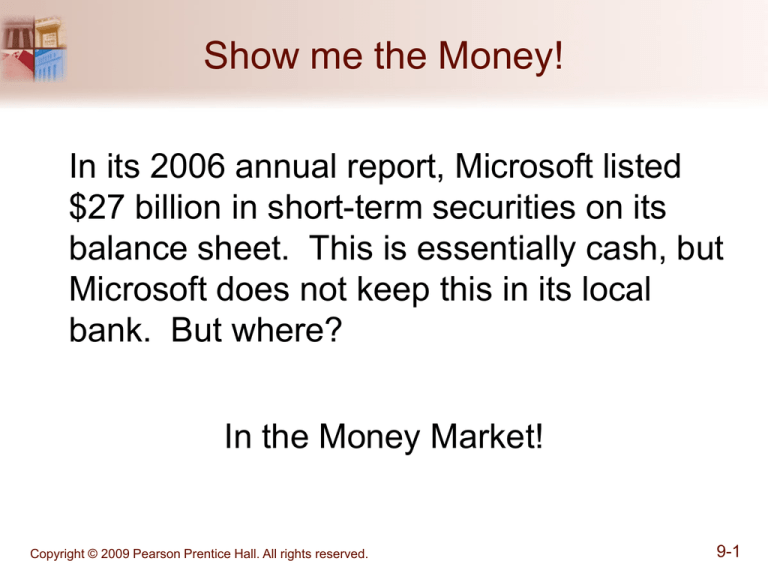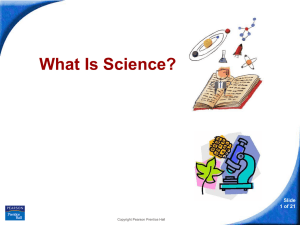Chapter 9
advertisement

Show me the Money! In its 2006 annual report, Microsoft listed $27 billion in short-term securities on its balance sheet. This is essentially cash, but Microsoft does not keep this in its local bank. But where? In the Money Market! Copyright © 2009 Pearson Prentice Hall. All rights reserved. 9-1 The Purpose of Money Markets • Investors in Money Market: Provides a place for warehousing surplus funds for short periods of time • Borrowers from money market provide lowcost source of temporary funds Copyright © 2009 Pearson Prentice Hall. All rights reserved. 9-2 The Purpose of Money Markets • Corporations and U.S. government use these markets because the timing of cash inflows and outflows are not well synchronized. Money markets provide a way to solve these cash-timing problems. Copyright © 2009 Pearson Prentice Hall. All rights reserved. 9-3 Who Participates in the Money Markets? Money Market Instruments • We will examine each of these in the following slides: – Treasury Bills – Federal Funds – Repurchase Agreements – Negotiable Certificates of Deposit Copyright © 2009 Pearson Prentice Hall. All rights reserved. 9-5 Money Market Instruments (cont.) • We will examine each of these in the following slides (continued): – Commercial Paper – Banker’s Acceptance – Eurodollars Copyright © 2009 Pearson Prentice Hall. All rights reserved. 9-6 Money Market Instruments: Treasury Bills • T-bills have 28-day maturities through 12month maturities. • Discounting: When an investor pays less for the security than it will be worth when it matures, and the increase in price provides a return. This is common to short-term securities because they often mature before the issuer can mail out interest checks. Copyright © 2009 Pearson Prentice Hall. All rights reserved. 9-7 Money Market Instruments: Treasury Bills Discounting Example • You pay $996.37 for a 28-day T-bill. It is worth $1,000 at maturity. What is its discount rate? F P 360 idiscount x F n (1) 1,000 996.73 360 idiscount x 4.665% 1,000 28 Copyright © 2009 Pearson Prentice Hall. All rights reserved. 9-8 Money Market Instruments: Treasury Bills Discounting Example • You pay $996.37 for a 28-day T-bill. It is worth $1,000 at maturity. What is its annualized yield? F P 365 iyt P n (1) 1,000 996.73 366 i yt x 4.76% 996.37 28 Copyright © 2009 Pearson Prentice Hall. All rights reserved. 9-9 Money Market Instruments: Treasury Bills Copyright © 2009 Pearson Prentice Hall. All rights reserved. 9-10 Money Market Instruments: Fed Funds • Short-term funds transferred (loaned or borrowed) between financial institutions, usually for a period of one day. • Used by banks to meet short-term needs to meet reserve requirements. Copyright © 2009 Pearson Prentice Hall. All rights reserved. 9-11 Money Market Instruments: Repurchase Agreements • These work similar to the market for fed funds, but nonbanks can participate. • A firm sells Treasury securities, but agrees to buy them back at a certain date (usually 3–14 days later) for a certain price. Copyright © 2009 Pearson Prentice Hall. All rights reserved. 9-12 Money Market Instruments: Repurchase Agreements • This set-up makes a repo agreements essentially a short-term collateralized loan. • This is one market the Fed may use to conduct its monetary policy, whereby the Fed purchases/sells Treasury securities in the repo market. Copyright © 2009 Pearson Prentice Hall. All rights reserved. 9-13 Money Market Instruments: Negotiable Certificates of Deposit • A bank-issued security that documents a deposit and specifies the interest rate and the maturity date • Denominations range from $100,000 to $10 million Copyright © 2009 Pearson Prentice Hall. All rights reserved. 9-14 Money Market Instruments: Commercial Paper • Unsecured promissory notes, issued by corporations, that mature in no more than 270 days. • The use of commercial paper increased significantly in the early 1980s because of the rising cost of bank loans. Copyright © 2009 Pearson Prentice Hall. All rights reserved. 9-15 Money Market Instruments: Commercial Paper Volume Copyright © 2009 Pearson Prentice Hall. All rights reserved. 9-16 Money Market Instruments: Banker’s Acceptances • An order to pay a specified amount to the bearer on a given date if specified conditions have been met, usually delivery of promised goods. • These are often used when buyers / sellers of expensive goods live in different countries. Copyright © 2009 Pearson Prentice Hall. All rights reserved. 9-17 Money Market Instruments: Banker’s Acceptances Advantages 1. Exporter paid immediately 2. Exporter shielded from foreign exchange risk 3. Exporter does not have to assess the financial security of the importer 4. Importer’s bank guarantees payment 5. Crucial to international trade Copyright © 2009 Pearson Prentice Hall. All rights reserved. 9-18 Money Market Instruments: Banker’s Acceptances • As seen, banker’s acceptances avoid the need to establish the credit-worthiness of a customer living abroad. • There is also an active secondary market for banker’s acceptances until they mature. The terms of note indicate that the bearer, whoever that is, will be paid upon maturity. Copyright © 2009 Pearson Prentice Hall. All rights reserved. 9-19 Money Market Instruments: Eurodollars • Eurodollars represent Dollar denominated deposits held in foreign banks. • The market is essential since many foreign contracts call for payment is U.S. dollars due to the stability of the dollar, relative to other currencies. Copyright © 2009 Pearson Prentice Hall. All rights reserved. 9-20 Money Market Instruments: Eurodollars Rates • London interbank bid rate (LIBID) – The rate paid by banks buying funds • London interbank offer rate (LIBOR) – The rate offered for sale of the funds • Time deposits with fixed maturities – Largest short term security in the world Copyright © 2009 Pearson Prentice Hall. All rights reserved. 9-21 Comparing Money Market Securities • The next slide shows a comparison of various money market rates from 1990 through 2007. • Notice that no real pattern is present among the rates, indicating that investor preferences to the features on the instruments fluctuates. Copyright © 2009 Pearson Prentice Hall. All rights reserved. 9-22 Comparing Money Market Securities : A comparison of rates Copyright © 2009 Pearson Prentice Hall. All rights reserved. 9-23 Comparing Money Market Securities: Money Market Securities and Their Depth Copyright © 2009 Pearson Prentice Hall. All rights reserved. 9-24




